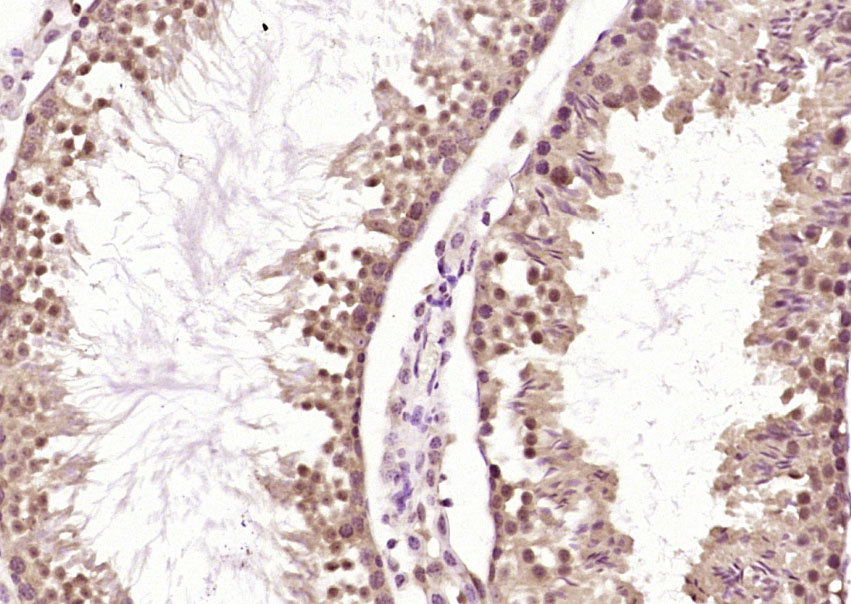WDFY3 Rabbit pAb
WDFY3 Rabbit pAb
- 产品详情
- 实验流程
- 背景知识
Application
| IHC-P, IHC-F, IF |
|---|---|
| Primary Accession | Q8IZQ1 |
| Reactivity | Mouse, Rat |
| Predicted | Human, Dog, Pig, Horse, Rabbit, Sheep |
| Host | Rabbit |
| Clonality | Polyclonal |
| Calculated MW | 395258 Da |
| Physical State | Liquid |
| Immunogen | KLH conjugated synthetic peptide derived from human WDFY3 |
| Epitope Specificity | 951-1050/3526 |
| Isotype | IgG |
| Purity | affinity purified by Protein A |
| Buffer | 0.01M TBS (pH7.4) with 1% BSA, 0.02% Proclin300 and 50% Glycerol. |
| SUBCELLULAR LOCATION | Membrane; Peripheral membrane protein; Cytoplasmic side. Note: Colocalizes with autophagic structures in starved cells. |
| SIMILARITY | Contains 1 BEACH domain. Contains 1 FYVE-type zinc finger. Contains 5 WD repeats. |
| Important Note | This product as supplied is intended for research use only, not for use in human, therapeutic or diagnostic applications. |
| Background Descriptions | WDFY3 was identified in a screen for phosphatidylinositol 3 phosphate binding proteins. The FYVE domain is a zinc binding domain found in many PtdIns binding proteins and is proposed to target proteins to membrane lipids. WDFY3 has been shown localized to the nuclear membrane and within autophagic membranes and it is proposed to function as a link between protein aggregates and the autophagic machinery. WDFY3 is also known as autophagy linked FYVE protein. |
| Gene ID | 23001 |
|---|---|
| Other Names | WD repeat and FYVE domain-containing protein 3, Autophagy-linked FYVE protein, Alfy, WDFY3, KIAA0993 |
| Target/Specificity | Ubiquitous. |
| Dilution | IHC-P=1:100-500,IHC-F=1:100-500,IF=1:100-500 |
| Storage | Store at -20 °C for one year. Avoid repeated freeze/thaw cycles. When reconstituted in sterile pH 7.4 0.01M PBS or diluent of antibody the antibody is stable for at least two weeks at 2-4 °C. |
| Name | WDFY3 |
|---|---|
| Synonyms | KIAA0993 |
| Function | Required for selective macroautophagy (aggrephagy). Acts as an adapter protein by linking specific proteins destined for degradation to the core autophagic machinery members, such as the ATG5- ATG12-ATG16L E3-like ligase, SQSTM1 and LC3 (PubMed:20417604). Along with p62/SQSTM1, involved in the formation and autophagic degradation of cytoplasmic ubiquitin-containing inclusions (p62 bodies, ALIS/aggresome-like induced structures). Along with SQSTM1, required to recruit ubiquitinated proteins to PML bodies in the nucleus (PubMed:20168092). Important for normal brain development. Essential for the formation of axonal tracts throughout the brain and spinal cord, including the formation of the major forebrain commissures. Involved in the ability of neural cells to respond to guidance cues. Required for cortical neurons to respond to the trophic effects of netrin-1/NTN1 (By similarity). Regulates Wnt signaling through the removal of DVL3 aggregates, likely in an autophagy-dependent manner. This process may be important for the determination of brain size during embryonic development (PubMed:27008544). May regulate osteoclastogenesis by acting on the TNFSF11/RANKL - TRAF6 pathway (By similarity). After cytokinetic abscission, involved in midbody remnant degradation (PubMed:24128730). In vitro strongly binds to phosphatidylinositol 3-phosphate (PtdIns3P) (PubMed:15292400). |
| Cellular Location | Nucleus membrane. Cytoplasm, cytosol. Nucleus, PML body. Membrane; Peripheral membrane protein; Cytoplasmic side Perikaryon {ECO:0000250|UniProtKB:Q6VNB8}. Cell projection, axon {ECO:0000250|UniProtKB:Q6VNB8}. Note=Relocalization from the nucleus to the cytosol is stimulated by cellular stress, such as starvation or proteasomal inhibition. In the cytosol of starved cells, colocalizes with autophagic structures (PubMed:15292400, PubMed:20168092, PubMed:20417604, PubMed:20971078). This redistribution is dependent on p62/SQSTM1 (PubMed:20168092). When nuclear export is blocked by treatment with leptomycin B, accumulates in nuclear bodies, that completely or partially colocalize with promyelocytic leukemia (PML) bodies (PubMed:20168092). Localizes throughout neurons, including within axons. In neurons, enriched in the light membrane fraction along with the synaptosomal membrane protein synaptophysin and the membrane- bound form of LC3/MAP1LC3A/MAP1LC3B, called LC3-II, a classic marker for autophagic vesicles (By similarity). {ECO:0000250|UniProtKB:Q6VNB8, ECO:0000269|PubMed:15292400, ECO:0000269|PubMed:20168092, ECO:0000269|PubMed:20417604, ECO:0000269|PubMed:20971078} |
| Tissue Location | Expressed in osteoclast and their mononuclear precursors (at protein level). |
For Research Use Only. Not For Use In Diagnostic Procedures.
Provided below are standard protocols that you may find useful for product applications.
BACKGROUND
WDFY3 was identified in a screen for phosphatidylinositol 3 phosphate binding proteins. The FYVE domain is a zinc binding domain found in many PtdIns binding proteins and is proposed to target proteins to membrane lipids. WDFY3 has been shown localized to the nuclear membrane and within autophagic membranes and it is proposed to function as a link between protein aggregates and the autophagic machinery. WDFY3 is also known as autophagy linked FYVE protein.
终于等到您。ABCEPTA(百远生物)抗体产品。
点击下方“我要评价 ”按钮提交您的反馈信息,您的反馈和评价是我们最宝贵的财富之一,
我们将在1-3个工作日内处理您的反馈信息。
如有疑问,联系:0512-88856768 tech-china@abcepta.com.























 癌症的基本特征包括细胞增殖、血管生成、迁移、凋亡逃避机制和细胞永生等。找到癌症发生过程中这些通路的关键标记物和对应的抗体用于检测至关重要。
癌症的基本特征包括细胞增殖、血管生成、迁移、凋亡逃避机制和细胞永生等。找到癌症发生过程中这些通路的关键标记物和对应的抗体用于检测至关重要。 为您推荐一个泛素化位点预测神器——泛素化分析工具,可以为您的蛋白的泛素化位点作出预测和评分。
为您推荐一个泛素化位点预测神器——泛素化分析工具,可以为您的蛋白的泛素化位点作出预测和评分。 细胞自噬受体图形绘图工具为你的蛋白的细胞受体结合位点作出预测和评分,识别结合到自噬通路中的蛋白是非常重要的,便于让我们理解自噬在正常生理、病理过程中的作用,如发育、细胞分化、神经退化性疾病、压力条件下、感染和癌症。
细胞自噬受体图形绘图工具为你的蛋白的细胞受体结合位点作出预测和评分,识别结合到自噬通路中的蛋白是非常重要的,便于让我们理解自噬在正常生理、病理过程中的作用,如发育、细胞分化、神经退化性疾病、压力条件下、感染和癌症。






